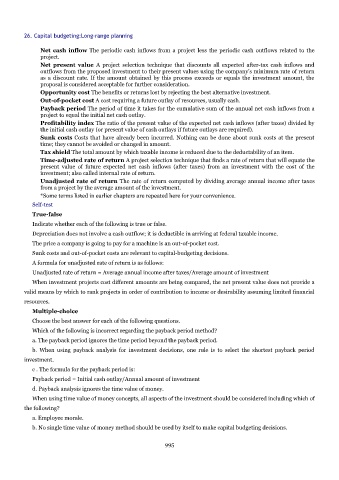Page 994 - Accounting Principles (A Business Perspective)
P. 994
26. Capital budgeting:Long-range planning
Net cash inflow The periodic cash inflows from a project less the periodic cash outflows related to the
project.
Net present value A project selection technique that discounts all expected after-tax cash inflows and
outflows from the proposed investment to their present values using the company's minimum rate of return
as a discount rate. If the amount obtained by this process exceeds or equals the investment amount, the
proposal is considered acceptable for further consideration.
Opportunity cost The benefits or returns lost by rejecting the best alternative investment.
Out-of-pocket cost A cost requiring a future outlay of resources, usually cash.
Payback period The period of time it takes for the cumulative sum of the annual net cash inflows from a
project to equal the initial net cash outlay.
Profitability index The ratio of the present value of the expected net cash inflows (after taxes) divided by
the initial cash outlay (or present value of cash outlays if future outlays are required).
Sunk costs Costs that have already been incurred. Nothing can be done about sunk costs at the present
time; they cannot be avoided or changed in amount.
Tax shield The total amount by which taxable income is reduced due to the deductability of an item.
Time-adjusted rate of return A project selection technique that finds a rate of return that will equate the
present value of future expected net cash inflows (after taxes) from an investment with the cost of the
investment; also called internal rate of return.
Unadjusted rate of return The rate of return computed by dividing average annual income after taxes
from a project by the average amount of the investment.
*Some terms listed in earlier chapters are repeated here for your convenience.
Self-test
True-false
Indicate whether each of the following is true or false.
Depreciation does not involve a cash outflow; it is deductible in arriving at federal taxable income.
The price a company is going to pay for a machine is an out-of-pocket cost.
Sunk costs and out-of-pocket costs are relevant to capital-budgeting decisions.
A formula for unadjusted rate of return is as follows:
Unadjusted rate of return = Average annual income after taxes/Average amount of investment
When investment projects cost different amounts are being compared, the net present value does not provide a
valid means by which to rank projects in order of contribution to income or desirability assuming limited financial
resources.
Multiple-choice
Choose the best answer for each of the following questions.
Which of the following is incorrect regarding the payback period method?
a. The payback period ignores the time period beyond the payback period.
b. When using payback analysis for investment decisions, one rule is to select the shortest payback period
investment.
c . The formula for the payback period is:
Payback period = Initial cash outlay/Annual amount of investment
d. Payback analysis ignores the time value of money.
When using time value of money concepts, all aspects of the investment should be considered including which of
the following?
a. Employee morale.
b. No single time value of money method should be used by itself to make capital budgeting decisions.
995

